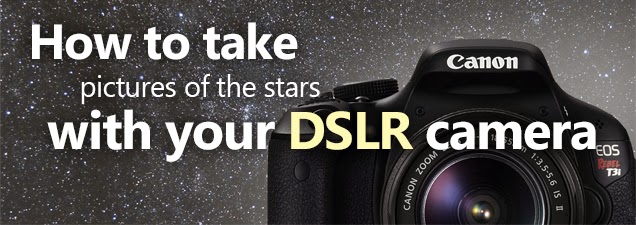 |
|
| Anyone with access to a DSLR camera and a
tripod (or a steady surface) can take stunning photos of the night sky with
all of its glorious stars! You will even start to see some Nebulae, Galaxies,
Globular Clusters, the Milky Way, Meteorites, Auroras and more! It is a
wonderful experience that may help you learn some of the
constellations as well. A camera sensor, like the one in your DSLR, is capable
of letting in much more light than our eyes. This is why we are able to see
much more detail in a photograph than with our naked eye alone. Whether you
are just getting started with a new camera, or you have never taken any night
photography before, the simple steps below should have you on your way. Here is a basic guide to taking pictures of the stars and milky way with your DSLR camera! |
|
|
|
|
| The first thing you will need to
understand is that in order to capture enough light for your camera’s
sensor to pick up lots of stars in the photo, you will need to take a
long exposure photograph. This can range from 5-30+ seconds depending on
your equipment. To do this you will want to make sure your DSLR is in
Manual Mode. This will be indicated by an M on your camera’s dial. If you are
shooting with a lens that has a focal length of 18mm, you shouldn't see any
star trails (due to the rotation of the earth!) until you shoot an exposure of
about 25 seconds. For this guide, we used a Canon 18-200mm F3.5 lens, at the
widest focal length of 18mm. Now that the camera is on the proper mode, you will need to apply some additional settings to maximize the brightness and the amount of the stars, nebulae and galaxies. Getting photos of the night sky is all about letting as much light into the camera as possible. That means you will want a large aperture to maximize the light you let in. On my camera lens, that is a setting of F3.5. The lower the F-number, the more light the camera brings in. |
|
 |
The next setting you will want to adjust is ISO. This is the
cameras sensitivity to light, which is very important for our purposes!
Generally, you will want to use the highest ISO your camera has, this
may by 1600, or even 6400 or higher. Increasing your ISO will
introduce more noise to your photo, but the trade-off is more stars and
more light-gathering ability. You may want to use a lower ISO if you are
finding your photo to be too noisy. Modern photo-editing software like
Photoshop CC does a great job a reducing noise in post-processing. For our purposes, Auto White Balance or Daylight White Balance works just fine. You also want to make sure that you are shooting your photos in RAW format. This gives you the opportunity to really bring out the images full potential in post-processing. You will need Adobe photoshop to make these adjustments, so if you don't have it, a .JPG photo will have to do! |
| Now that you have the proper
settings for night-time photography, you are ready to point your DSLR to
the heavens and capture more stars than you have ever seen with your
naked eye alone! Securlely fasten your camera to your tripod via
the removable mounting plate. Make sure that all of your adjustment
knobs are tight before leaving your camera on the tripod. DSLR's
can be heavy, and you will be angling the head straight-up in some
cases. FOCUS To acheive proper focus of the stars, do not use autofocus. Manually focus your lens to infinity, then focus back a hair. Take some test shots and try to get the stars to look as tight as possible. Another way to achieve focus is to use the live-view mode of your camera, and focus on something far away (like a street lamp). Zoom-in while in live-view to really get it right. STAR TRAILS In a 30 second exposure, you will notice small star trails because of earths rotation. (Yes, even in 30 seconds!) The star-trailing is subtle, and will not effect the overall look you are trying to achieve. If the stars are trailing too much for your liking, knock your exposure down to 20 seconds if you wish. |
 |
|
|
ACTIVATING THE SHUTTER Set your drive mode to a 2 or 10 second delay to avoid shaking the camera slightly when activating the shutter. You can find this option in the Even the slightest movement (like pressing the shutter button) can be enough to create a shaky shot! The drive mode option screen should look something like this: THINGS TO WATCH FOR Make sure that your lens has not fogged up, or your shots will look blurry. A blow dryer will remove dew if necessary. Light pollution is your biggest enemy when it comes to astrophotography. Get as far away from city lights as possible for your star shots. If there is a city glow near you, point away from it. You may find that a shot in the city using a high ISO and long exposure produces a very bright, washed-out photo. If this is the case, bump your ISO down, and shoot a shorter exposure. eg. (ISO 800, 15 seconds) |
▼

No comments:
Post a Comment